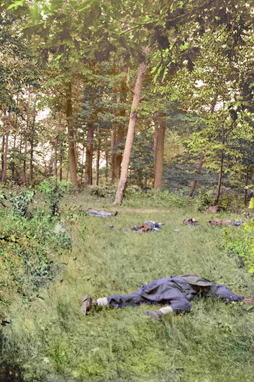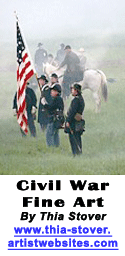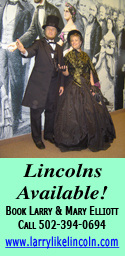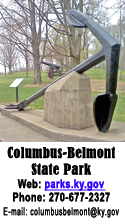|
Confederates in jungle are last survivors
of what South was like during Civil War
By RON SOODALTER
This particular Fourth of July setting is in the South – very far south, in Brazil.
The Festa Confederada is held as often as four times a year in Campo, an area carved out of the sugar cane fields outside Americana, a modern city of some 200,000 residents in the state of São Paulo. All the participants are “Confederados” – fifth-generation descendants of Southerners who immigrated here in the days following the Civil War. The entire scene – the dress, the music, food, even the conversation – is a carefully rendered homage to those disaffected rebels who elected to leave their conquered nation and make a new home in a foreign land. More
Opinion…
Many Americans are not aware
of when Civil War occurred
By DANIEL BURNETT
It was 1862 in war-weary Washington.
The Emancipation Proclamation, an executive order to free all slaves in areas still in rebellion, was not yet in effect. The United States had already suffered what still remains the bloodiest day in American military history – the Battle of Antietam. And from the U.S. Capitol, the secretary of the Senate read aloud President Abraham Lincoln’s Second Annual Message to Congress. More
Bugle book review…
Bush’s new book on Andrew Cowan
has to rank as one of his best efforts
Reviewed by
ED FORD
Bugle Editor
Bryan Bush probably knows more prominent Kentucky Civil War luminaries than any other War-Between-the-States specialist. And, he has written more than 13 books and innumerable magazine articles about them.
He continues that string with his latest book, Colonel Andrew Cowan, Union Soldier, Louisville Citizen, Peacemaker. More
Ely S. Parker. . .
True native American penned final copy
of surrender document at Appomattox
The occasion that officially ended the Civil War took place on Palm Sunday, April 9, 1865. The terms of surrender were recorded by Union Lt. Col. Ely S. Parker, a Seneca Indian.
Confederate Gen. Robert E. Lee met Parker after the surrender was finalized and remarked as he viewed the Colonel’s dark features: “I’m glad to see one real American here.”
Parker immediately replied, “We are all Americans.” More
Mountain Charley served Iowa regiment
as soldier, spy – although she was female
By DR. JUDY PIERCE
Bugle Staff Writer
During the beginning of the Civil War, a straggly, buckskin clothed man was mustered into the 3rd Iowa Cavalry Regiment in the city of Keokuk. His name on the regiment roster was “Mountain Charley” or “Charley Hatfield.” Unbeknownst to Gen. Samuel R. Curtis, “Mountain Charley” was really a female dressed as a mountain man.
Charlotte Hatfield was born in an agricultural area of Iowa in 1840. Her mother died when Charlotte was 18 years old, leaving her in the custody of her stepfather. He treated Charlotte as a hired hand and quickly discouraged any young man who seemed interested in her. More
|
|
|
Kentucky’s Civil War leaders . . .
Gen. Robertson popular with his troops
because of unusual concern for welfare
(EDITOR’S NOTE: This is the 33rd in a series about Kentucky’s officers and battle leaders during the Civil War.)
Confederate Brig. Gen. Jerome B. Robertson, a Woodford County native, was a physician, Indian fighter and a Texas politician who was noted for his service in the famed Texas Brigade in the Army of Northern Virginia.
When Robertson was only four years old, his father died leaving his mother almost penniless. Unable to properly support her family, she apprenticed young Robertson four years later to a hatter who moved with the boy in 1824 to St. Louis. After studying medicine at Transylvania College, Robertson graduated in 1835. More
German 48ers concluded progress
was made through blood and iron
By DOUG LIPPMAN
Bugle Staff Writer
As the United States and Mexico were ending their war in 1848, the flames of revolution were spreading throughout Europe. With the exception of England, every European nation experienced attempts to overthrow the Old Regime and institute a more progressive Republican form of government. For the most part, these revolutions failed, as the military supported the aristocracy. This led to a mass migration which sent hundreds of thousands of Germans to the New World.
There were many Germans living in America already, principally in the north. These Germans tended to be more conservative than their immigrating compatriots, and they distinguished the new immigrants by referring to them as 48ers. While the early arrivals were fervently patriotic, they did not share the revolutionary idealism of their frustrated countrymen. More
Neither rain, nor mud could deter
re-enactors from Battle of Sacramento
By DON WILKINS
Owensboro Messenger-Inquirer
Neither the rain nor the mud could deter the hundreds of Civil War re-enactors from taking part in the May 17 annual Battle of Sacramento.
Re-enactor Bill Sanders of Louisville has been faithfully attending the Sacramento battle since 1996. Sanders, who was encamped with the Confederate Fifth Kentucky, Company B unit, spent his time providing rifle demonstrations to anyone who wanted to know how it felt to hold and aim a nearly 10-pound Civil War rifle.
“This is hands-on history,” Sanders noted. “For me, it’s eight mini-vacations to help take off the pressure.” More
Bugle Briefs
They speak in manner of ‘Old South’
One of the most prominent cultural features among Brazil’s Confederados is the manner in which they’ve maintained their identity through speech. In the lead story in this issue about the Southerners who fled America following the Civil War, it is noted their style of English is perfect to that of the Old South.
Most of the fifth generation offspring of those who initially arrived in Brazil have never visited the United States, but it would not be evident by the way they speak. When Jimmy Carter, then governor of Georgia, visited the village near Americana in 1972, he said, “The most remarkable thing was, when they spoke they sounded just like people in South Georgia.” More
With dignity, sense of purpose, Lee
continued to lead after Civil War
Even in defeat, Robert E. Lee was looked upon as the leader of the South. With the war still raging in the spring of 1865, discussion in the high command revolved around how to continue the Confederate war effort. More
|
|
|

















